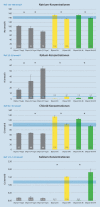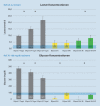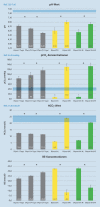[Improved quality of stored packed red blood cells by mechanical rinsing]
- PMID: 35969253
- PMCID: PMC9636120
- DOI: 10.1007/s00101-022-01189-6
[Improved quality of stored packed red blood cells by mechanical rinsing]
Abstract
Background: The transfusion of packed red blood cells (PRBC) is associated with various side effects, including storage damage to PRBCs. The cells change their structure, releasing potassium as well as lactate. Mechanical rinsing, available in many hospitals, is able to remove toxic substances and possibly minimizes the negative side effects of transfusion.
Objective: The primary aim of our study was to improve the quality of PRBCs before transfusion. The effects of different washing solutions on PRBC quality were analyzed.
Material and methods: This in vitro study compares 30 mechanically washed PRBCs. They were either processed with standard normal saline 0.9% (n = 15, N group) or a hemofiltration solution containing 4 mmol/l potassium (n = 15, HF group) by a mechanical rinsing device (Xtra, LivaNova, Munich, Germany). A subgroup analysis was performed based on the storage duration of the processed PRBCs (7, 14, 37 days). Samples were taken before washing (EKprä), immediately after washing (EKpost) and 10 h later (EKpost10h), after storage in the "wash medium" at room temperature. Concentrations of ATP (probability of survival in transfused erythrocytes), lactate, citrate and electrolytes (potassium, sodium, chloride, calcium) were tested.
Results and conclusion: Mechanical rinsing improves pretransfusion quality of PRBC. Washing with a hemofiltration solution results in a more physiological electrolyte composition. Even 10 h after mechanical rinsing with a hemofiltration solution, the quality of 37-day-old PRBC is comparable to young PRBC that have been stored for 7 days and have not been washed. Washing stored PRBC increases the ATP content, which subsequently leads to an increased probability of survival of red cells after transfusion.
Zusammenfassung: HINTERGRUND: Die Transfusion von Erythrozytenkonzentraten (EK) ist mit verschiedenen Nebenwirkungen assoziiert, die u. a. durch Lagerungsschäden an Erythrozyten hervorgerufen werden. Die Zellen verändern ihre Struktur und setzen dabei Kalium sowie Lactat frei. Zur Minimierung dieser negativen Effekte können die Erythrozyten mithilfe einer maschinellen Autotransfusion (MAT) unter Verwendung von Waschlösungen aufgereinigt werden.
Ziel der arbeit: Untersuchung der Auswirkungen zweier Waschlösungen auf die gelagerten Erythrozyten.
Material und methode: In der vorliegenden Studie wurden 30 EK mittels MAT (Xtra, LivaNova, München, Deutschland) gewaschen. Der Goldstandard 0,9 %ige Kochsalzlösung (n = 15; N‑Gruppe) wurde mit einer 4 mmol/l kaliumhaltigen Hämofiltrationslösung (HF) (n = 15; HF-Gruppe; Duosol) verglichen. In einer Subgruppenanalyse wurde eine Differenzierung bezogen auf die Lagerdauer der EK (7, 14, 37 Tage) bis zur Durchführung der MAT vorgenommen. Untersucht wurde der Einfluss der Waschlösungen sowie des EK-Alters auf ATP, Lactat, Glucose, Elektrolyte und Zitrat zu drei Messzeitpunkten vor MAT (EKprä), unmittelbar danach (EKpost) und nach 10 h im Retransfusionsbeutel (EKpost10h).
Ergebnisse und diskussion: Die ATP-Konzentration nimmt durch die MAT-Waschung von EKprä zu EKpost signifikant zu (n = 30). Bei 37 Tage alten EK nimmt die ATP-Konzentration in der HF-Gruppe nach MAT stärker zu als in der N‑Gruppe. Durch die MAT-Waschung werden die Kalium‑, Lactat‑, Glucose- und Zitratkonzentration signifikant reduziert. Die MAT-Behandlung gelagerter EK verbessert deren Qualität. Das Waschen mit einer HF-Lösung führt zu einer physiologischeren Elektrolytzusammensetzung. Selbst 10 h nach MAT mit einer HF-Lösung ist die Qualität eines 37 Tage alten EK bezüglich der untersuchten Parameter mit einem jungen 7 Tage gelagerten, nichtgewaschenen EK vergleichbar.
Keywords: Cell Saving; Hemofiltration solution; Packed red blood cells; Physiological saline solution; Storage lesion.
© 2022. The Author(s).
Similar articles
-
Comparison of bicarbonate-buffered fluid and isotonic saline solution as Cell Saver washing fluids for packed red blood cells.Paediatr Anaesth. 2013 Nov;23(11):1021-6. doi: 10.1111/pan.12232. Epub 2013 Aug 1. Paediatr Anaesth. 2013. PMID: 23910018
-
Serial assessment of biochemical changes in irradiated red blood cells.Transfus Apher Sci. 2014 Jun;50(3):479-87. doi: 10.1016/j.transci.2014.02.002. Epub 2014 Feb 15. Transfus Apher Sci. 2014. PMID: 24594298
-
The in vitro quality of washed, prestorage leucocyte-depleted red blood cell concentrates.Vox Sang. 2004 Jul;87(1):19-26. doi: 10.1111/j.1423-0410.2004.00526.x. Vox Sang. 2004. PMID: 15260818
-
A comparative study of reducing the extracellular potassium concentration in red blood cells by washing and by reduction of additive solution.Transfusion. 2007 Feb;47(2):248-50. doi: 10.1111/j.1537-2995.2007.01095.x. Transfusion. 2007. PMID: 17302770
-
The involvement of cation leaks in the storage lesion of red blood cells.Front Physiol. 2014 Jun 17;5:214. doi: 10.3389/fphys.2014.00214. eCollection 2014. Front Physiol. 2014. PMID: 24987374 Free PMC article. Review.
References
-
- Bundesärztekammer. Richtlinie zur Gewinnung von Blut und Blutbestandteilen und zur Anwendung von Blutprodukten (Richtlinie Hämotherapie) – Aufgestellt gemäß §§ 12a und 18 Transfusionsgesetz von der Bundesärztekammer im Einvernehmen mit dem Paul-Ehrlich-Institut. Gesamtnovelle 2017. Deutscher Ärzteverlag, Köln, 2017.
-
- (2011) LivaNova: Gebrauchsanweisung Xtra. https://www.livanova.com/en-gb/home/cardiopulmonary/autotransfusion/xtra. Zugegriffen: 19. März 2022
Publication types
MeSH terms
Substances
LinkOut - more resources
Full Text Sources
Research Materials
Miscellaneous





